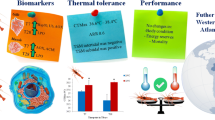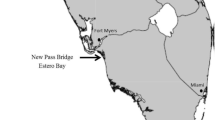Abstract
Anthropogenic effects on marine ecosystems (e.g. hypoxia, warming) at and beyond continental margins are assumed to affect physiological and biochemical boundaries to species’ distributions, potentially leading to habitat contraction across depth. Whether or not shallow-water benthic invertebrates are capable of undergoing depth-related migrations in response to such perturbations remains largely unknown. The few studies available have focused solely on whether colonisation of deep waters may be ongoing and on the ability of shallow-water species to tolerate low temperatures and high hydrostatic pressures: two physical parameters, which are thought to limit the depth range of a species. Those studies did not consider the effects of acclimation to low temperature and, especially, acclimation to high hydrostatic pressure on pressure tolerance. We demonstrate that acclimation to both low temperature (5 °C) and to high hydrostatic pressure (10 MPa) increases the pressure tolerance within the shallow-water shrimp Palaemonetes varians. Previous studies have demonstrated the impressive temperature and pressure tolerance of this shallow-water shrimp. Here, we provide evidence that a shallow-water species may acclimate to low temperature and high pressure and show greater pressure tolerance, suggesting that shallow-water organisms may be able to rapidly—and potentially stepwise—acclimate to the low temperature and high pressure conditions typical of the deep sea. These findings are of importance for understanding phylogenetic development from shallow- to deep-water species and the processes behind past, present and future bathymetric range shifts in species.




Similar content being viewed by others
References
Aquino-Souza RJ, Hawkins SJ, Tyler PA (2008) Early development and larval survival of Psammechinus miliaris under deep-sea temperature and pressure conditions. J Mar Biol Assoc UK 88:453–461
Avent RM (1975) Evidence for acclimation to hydrostatic pressure in Uca pugilator (Crustacea: Decapoda: Ocypodidae). Mar Biol 31:193–199
Bartlett D, Wright M, Yayanos AA (1989) Isolation of a gene regulated by hydrostatic pressure in a deep-sea bacterium. Nature 342:572–574
Behan MK, MacDonald AG, Jones GR, Cossins AR (1992) Homeoviscous adaptation under pressure: the pressure dependence of membrane order in brain myelin membranes of deep-sea fish. Biochim Biophys Acta 1103:317–323
Brown A, Thatje S (2011) Respiratory response of the deep-sea amphipod Stephonyx biscayensis indicates bathymetric range limitation by temperature and hydrostatic pressure. PLoS ONE 6:e28562. doi:10.1371/journal.pone.0028562
Brown A, Thatje S (2013) Explaining bathymetric diversity patterns in marine benthic invertebrates and demersal fishes: physiological contributions to adaptation of life at depth. Biol Rev. doi:10.1111/brv.12061
Clarke A (1991) What is cold adaptation and how should we measure it? Am Zool 31:81–92
Cossins AR, MacDonald AG (1989) The adaptation of biological membranes to temperature and pressure: fish from deep and cold. J Bioenerg Biomembr 21:115–135
Cottin D, Shillito B, Chertemps T, Thatje S, Léger N, Ravaux J (2010) Comparison of heat-shock responses between the hydrothermal vent shrimp Rimicaris exoculata and the related coastal shrimp Palaemonetes varians. J Exp Mar Biol Ecol 393:9–16
Cottin D, Brown A, Oliphant A, Mestre NC, Ravaux J, Shillito B, Thatje S (2012) Sustained hydrostatic pressure tolerance of the shallow water shrimp Palaemonetes varians at different temperatures: insights into the colonisations of the deep sea. Comp Biochem Physiol A 162:357–363
Cramer BS, Miller KG, Barrett PJ, Wright JD (2011) Late Cretaceous-Neogene trends in deep ocean temperature and continental ice volume: reconciling records of benthic foraminiferal geochemistry (δ18O and Mg/Ca) with sea level history. J Geophys Res 116:C12023
Distel DL, Baco AR, Chuang E, Morrill W, Cavanaugh C, Smith CR (2000) Marine ecology: do mussels take wooden steps to deep-sea vents? Nature 403:725–726
Dolmen D, Hindley JD, Kleiven E (2004) Distribution of Palaemonetes varians (Leach) (Crustacea, Decapoda) in relation to biotope and other caridean shrimps in brackish waters of southern Norway and southwestern Sweden. Sarsia 89:8–21
Farkas T, Storebakken T, Bhosie NB (1988) Composition and physical state of phospholipids in calanoid copepods from India and Norway. Lipids 23:619–622
Hall S, Thatje S (2009) Global bottlenecks in the distribution of marine Crustacea: temperature constraints in the family Lithodidae. J Biogeogr 36:2125–2135
Hazel JR (1995) Thermal adaptation in biological-membranes: is homeoviscous adaptation the explanation? Annu Rev Physiol 57:19–42
Hazel JR, Williams EE (1990) The role of alterations in membrane lipid composition in enabling physiological adaptation or organisms to their physical environment. Prog Lipid Res 29:167–227
Hindley J (2001) The population and dynamics of the estuarine prawn (Palaemonetes varians) (Leach) and its interrelationships with the common goby (Pomatoschistus microps) (Krøyer) in brackish biotopes of the Ribble Estuary, England. PhD thesis, Lancaster University, UK
Horne DJ (1999) Ocean circulation modes of the Phanerozoic: implications for the antiquity of deep-sea benthonic invertebrates. Crustaceana 72:999–1018
Jablonski D, Bottjer DJ (1991) Environmental patterns in the origins of higher taxa: the post-paleozoic fossil record. Science 252:1831–1833
Jablonski D, Seposki JJ, Bottjer DJ, Sheehan PM (1983) Onshore-offshore patterns in the evolution of Phanerozoic shelf communities. Science 222:1123–1125
Kussakin OG (1973) Peculiarities of the geographical and vertical distribution of marine isopods and the problem of deep-sea fauna origin. Mar Biol 23:19–34
Levin LA, Sibuet M (2012) Understanding continental margin biodiversity: a new imperative. Annu Rev Mar Sci 4:79–112
Li CP, De Grave S, Chan TY, Lei HC, Chu KH (2011) Molecular systematics of caridean shrimps based on five nuclear genes: implications for superfamily classification. Zool Anzeiger 250:270–279
MacDonald AG (1997) Hydrostatic pressure as an environmental factor in life processes. Comp Biochem Physiol Part A 116:291–297
Mestre NC, Thatje S, Tyler PA (2009) The ocean is not deep enough: pressure tolerances during early ontogeny of the blue mussel Mytilus edulis. Proc R Soc B 276:717–726
Mestre NC, Brown A, Thatje S (2013) Temperature and pressure tolerance of larvae of Crepidula fornicata suggest thermal limitation of bathymetric range. Mar Biol 160:743–750
Mickel TJ, Childress JJ (1982) Effects of pressure and pressure acclimation in activity and oxygen consumption in the bathypelagic mysid Gnathophausia ingens. Deep-Sea Res Part I 29:1293–1301
Minin KV (2012) Vertical trends in morphological variability of sea urchins of the genus Echinus from the Northeast Atlantic and Arctic. Paleontol J 46:927–935
Oliphant A, Thatje S, Brown A, Morini M, Ravaux J, Shillito B (2011) Pressure tolerance of the shallow-water caridean shrimp Palaemonetes varians across its thermal tolerance window. J Exp Biol 241:1109–1117
Peck LS (2005) Prospects for survival in the Southern Ocean: vulnerability of benthic species to temperature change. Antarct Sci 17:497–507
Pörtner HO (2001) Climate change and temperature-dependent biogeography: oxygen limitation of thermal tolerance in animals. Naturwissenschaften 88:137–146
Pörtner HO (2002) Climate variations and the physiological basis of temperature dependent biogeography: systemic to molecular hierarchy of thermal tolerance in animals. Comp Biochem Physiol A 132:739–761
Pradillon F, Gaill F (2007) Pressure and life: some biological strategies. Rev Environ Sci Biotechnol 6:181–195
Raupach MJ, Mayer C, Malyutina M, Wägele JW (2009) Multiple origins of deep-sea Asellota (Crustacea: Isopoda) from shallow waters revealed by molecular data. Proc R Soc B 276:799–808
Ravaux J, Gaill F, Le Bris N, Sarradin PM, Jollivet DB, Shillito B (2003) Heat-shock response and temperature resistance in the deep-sea vent shrimp Rimicaris exoculata. J Exp Biol 206:2345–2354
Ravaux J, Leger N, Rabet N, Morini M, Zbinden M, Thatje S, Shillito B (2012) Adaptation to thermally variable environments: capacity for acclimation of thermal limit and heat shock response in the shrimp Palaemonetes varians. J Comp Physiol B 182:899–907
Rogers AD (2000) The role of the oceanic oxygen minima in generating biodiversity in the deep sea. Deep-Sea Res Part II 47:119–148
Ronges D, Walsh JP, Sinclair BJ, Stillman JH (2012) Changes in extreme cold tolerance, membrane composition and cardiac transcriptome during the first day of thermal acclimation in the porcelain crab Petrolisthes cinctipes. J Exp Biol 215:1824–1836
Sebert P (2002) Fish at high pressure: a hundred year history. Comp Biochem Physiol Part A 131:575–585
Shillito B, Jollivet D, Sarradin PM, Rodier P, Lallier F, Desbruyères D, Gaill F (2001) Temperature resistance of Hesiolyra bergi, a polychaetous annelid living on deep-sea vent smoker walls. Mar Ecol Prog Ser 216:141–149
Shillito B, Le Bris N, Hourdez S, Ravaux J, Cottin D, Caprais JC, Jollivet D, Gaill F (2006) Temperature resistance studies on the deep-sea vent shrimp Mirocaris fortunata. J Exp Biol 209:945–955
Smith KE, Thatje S (2012) The secret to successful deep-sea invasion: does low temperature hold the key. PLoS ONE 7:e51219. doi:10.1371/journal.pone.0051219
Somero GN (1992) Adaptations to high hydrostatic pressure. Annu Rev Physiol 54:557–577
Somero GN (2003) Protein adaptations to temperature and pressure: complementary roles of adaptive changes in amino acid sequence and internal milieu. Comp Biochem Physiol B 136:577–591
Sommer AM, Pörtner HO (2004) Mitochondrial function in seasonal acclimatization versus latitudinal adaptation to cold in the lugworm Arenicola marina (L.). Physiol Biochem Zool 77:174–186
Thatje S, Hillenbrand CD, Larter R (2005) On the origin of Antarctic marine benthic community structure. Trends Ecol Evol 20:534–540
Theron M, Guerrero F, Sebert P (2000) Improvement in the efficiency of oxidative phosphorylation in the freshwater eel acclimated to 10.1 MPa hydrostatic pressure. J Exp Biol 203:3019–3023
Tokuda G, Yamada A, Nakano K, Arita N, Yamasaki H (2006) Occurrence and recent long distance dispersal of deep-sea hydrothermal vent shrimps. Biol Lett 2:257–260
Tyler PA, Young CM, Serafy K (1995) Distribution, diet and reproduction in the genus Echinus: evidence for recent diversification? In: Emson R, Smith A, Campbell A (eds) Echinoderm research. Balkema, Rotterdam, pp 29–35
Tyler PA, Young CM, Clarke A (2000) Temperature and pressure tolerances of embryos and larvae of the Antarctic sea urchin Sterechinus neumayeri (Echinodermata: Echinoidea): potential for deep-sea invasion from high latitudes. Mar Ecol Prog Ser 192:173–180
Villalobos FB, Tyler PA, Young CM (2006) Temperature and pressure tolerance of embryos and larvae of the Atlantic seastars Asterias rubens and Marthasterias glacialis (Echinodermata: Asteroidea): potential for deep-sea invasion. Mar Ecol Prog Ser 314:109–117
Waagner D, Holmstrup M, Bayley M, Sørensen JG (2013) Induced cold-tolerance mechanisms depend on the duration of acclimation in the chill-sensitive Folsomia candida (Collembola). J Exp Biol 216:1991–2000
Wilson GDF (1999) Some of the deep-sea fauna is ancient. Crustaceana 72:1019–1030
Young CM, Tyler PA, Fenaux L (1997) Potential for deep sea invasion by Mediterranean shallow water echinoids: pressure and temperature as stage-specific dispersal barriers. Mar Ecol Prog Ser 154:193–209
Acknowledgments
AB was supported through a NERC PhD studentship, and AO through a studentship from the University of Southampton. The University of Southampton supported this research. Author contributions: AB, AO and ST conceived and designed experiments. PN, AB, AO, PB and AS performed experiments. PN, AB, AO, PB and AS analysed data. PN, AB, AO and ST wrote the manuscript.
Author information
Authors and Affiliations
Corresponding author
Additional information
Communicated by H.-O. Pörtner.
Rights and permissions
About this article
Cite this article
New, P., Brown, A., Oliphant, A. et al. The effects of temperature and pressure acclimation on the temperature and pressure tolerance of the shallow-water shrimp Palaemonetes varians . Mar Biol 161, 697–709 (2014). https://doi.org/10.1007/s00227-013-2371-9
Received:
Accepted:
Published:
Issue Date:
DOI: https://doi.org/10.1007/s00227-013-2371-9




